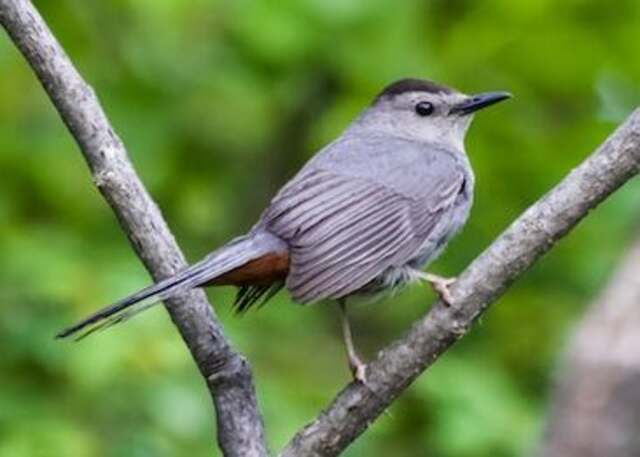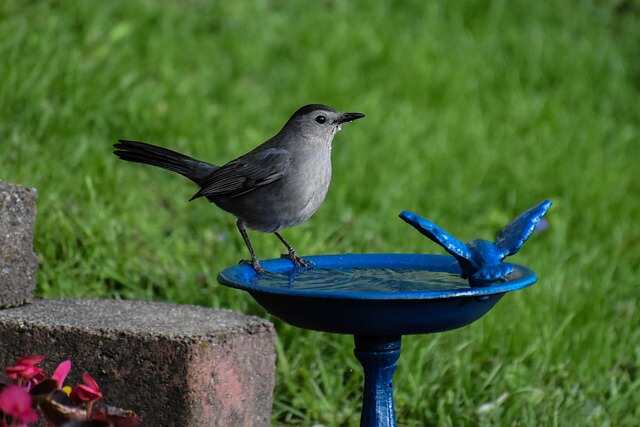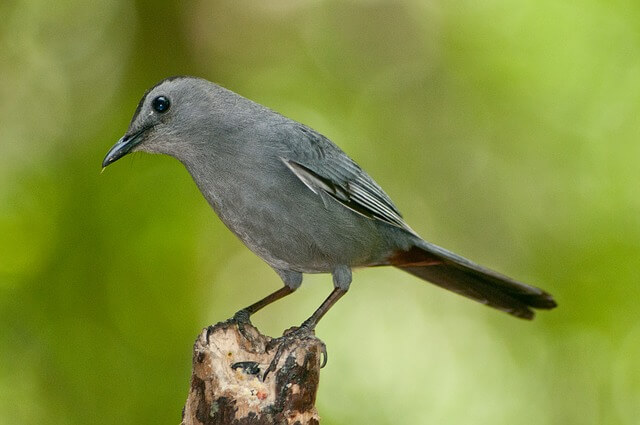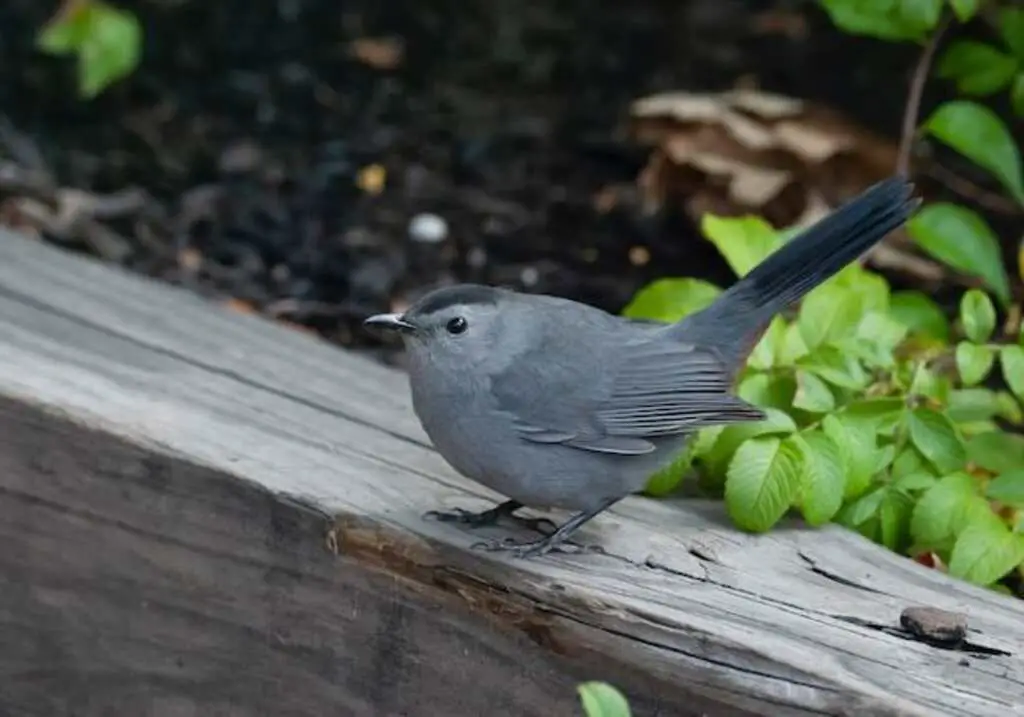Welcome to a fascinating journey through the world of the Gray Catbird, a bird shrouded in mystery and wonder. In this article, we’ll delve into 40 intriguing Gray Catbird interesting facts that may surprise and delight you.
From their unique behaviors and distinctive calls to their hidden talents and captivating habits, these facts will unveil the many secrets of this enigmatic avian species. So, let’s embark on an adventure of discovery and get to know the Gray Catbird in a whole new light.
Table of Contents
- 1 Gray Catbird (Species Overview)
- 2 Gray Catbird Interesting Facts
- 2.1 Gray Catbirds Are Masters of Impersonation
- 2.2 Gray Catbirds Are Insectivores
- 2.3 Gray Catbirds Have a Distinctive Call
- 2.4 Gray Catbirds Are Found Throughout North America
- 2.5 Gray Catbirds Are Monogamous
- 2.6 Gray Catbirds Build Cup-Shaped Nests
- 2.7 Gray Catbirds Are Aggressive Defenders of Their Territory
- 2.8 Gray Catbirds Are Part of the Mimidae Family
- 2.9 Gray Catbirds Have a Gray Plumage
- 2.10 Gray Catbirds Are Active During the Day
- 2.11 Gray Catbirds Have a Lifespan of 2-3 Years in the Wild
- 2.12 Gray Catbirds Are Considered a Species of Least Concern
- 2.13 Gray Catbirds Can Be Attracted to Bird Feeders
- 2.14 Gray Catbirds Are Vocal Communicators
- 2.15 Gray Catbirds Are Found in Wooded Areas and Suburban Gardens
- 2.16 Gray Catbirds Are Important Members of the Ecosystem
- 2.17 Gray Catbirds Are Skilled Hunters
- 2.18 Gray Catbirds Are Devoted Parents
- 2.19 Gray Catbirds Are Found in a Variety of Habitats
- 2.20 Gray Catbirds Are a Favorite of Birdwatchers
- 2.21 Gray Catbirds Have a Wide Range
- 2.22 Gray Catbirds Are Long-Distance Migrants
- 2.23 Gray Catbirds Have a Unique Flight Pattern
- 2.24 Gray Catbirds Are Social Birds
- 2.25 Gray Catbirds Are Named for Their Call
- 2.26 Gray Catbirds Have a Varied Diet
- 2.27 Gray Catbirds Are Vulnerable to Habitat Loss
- 2.28 Gray Catbirds Are Often Confused with Other Bird Species
- 2.29 Gray Catbirds Are Cavity Nesters
- 2.30 Gray Catbirds Have a Unique Mating Ritual
- 2.31 Gray Catbirds Are Threatened by Predators
- 2.32 Gray Catbirds Are Important Indicators of Ecosystem Health
- 2.33 Gray Catbirds Can Live in Urban Areas
- 2.34 Gray Catbirds Have a Short Migration Season
- 2.35 Gray Catbirds Are Protected by the Migratory Bird Treaty Act
- 2.36 Gray Catbirds Have a Unique Wing Structure
- 2.37 Gray Catbirds Are Important Seed Dispersers
- 2.38 Gray Catbirds Are Able to Recognize Individual Humans
- 2.39 Gray Catbirds Are a Symbol of Resilience
- 3 Author
Gray Catbird (Species Overview)

| Characteristic | Description |
|---|---|
| Bird Species | Gray Catbird (Dumetella carolinensis) |
| Length | Approximately 8 to 9 inches (20 to 23 centimeters) |
| Weight | Typically ranges from 23 to 34 grams |
| Wingspan | About 9.5 to 11 inches (24 to 28 centimeters) |
| Scientific Name | Dumetella carolinensis |
| Habitat | Varied, including woodlands, gardens, and shrubbery |
| Diet | Omnivorous, feeding on insects, berries, and fruits |
| Appearance | Gray plumage with a distinctive black cap |
| Song and Calls | Complex vocalizations with cat-like mewing sounds |
| Range | Found in North America, from Canada to the Caribbean |
| Nesting | Ground-nesting birds with well-hidden nests |
| Behavior | Shy and secretive, often foraging in dense shrubs |
| Migratory Status | Some populations are migratory |
| Conservation Status | Not globally threatened; stable populations |
Gray Catbird Interesting Facts
Gray Catbirds Are Masters of Impersonation
Gray Catbirds are known for their exceptional vocal abilities, imitating the sounds of other bird species and even mechanical noises with remarkable accuracy. This vocal mimicry helps them communicate with other birds, establish territory, and attract mates. Their diverse repertoire of sounds includes the songs of other birds, frogs, and even car alarms. Gray Catbirds are skilled mimics, and their vocal versatility is one of their most distinctive characteristics.
Gray Catbirds Are Insectivores
Gray Catbirds are primarily insectivores, feeding on a variety of insects and spiders. They are also known to consume fruits and berries during the winter months when insects are less abundant. Gray Catbirds are skilled hunters, using their sharp beaks to catch and consume their prey. They are important members of the ecosystem, helping to control insect populations and playing a vital role in maintaining the balance of nature.

Gray Catbirds Have a Distinctive Call
The “mew” call of Gray Catbirds is one of their most distinctive features. This call is often heard in wooded areas and suburban gardens, where these birds are commonly found. Gray Catbirds are vocal communicators, using their calls to communicate with other birds and establish their territory. Their vocal abilities are one of the reasons why they are a favorite subject of birdwatchers and bird photographers.
Gray Catbirds Are Found Throughout North America
Gray Catbirds are found throughout much of North America, from Canada to Mexico. They are adaptable to a variety of habitats and can be found in wooded areas, suburban gardens, and other habitats. Gray Catbirds are a common sight in many parts of the United States, and their distinctive appearance and vocalizations make them a popular bird to observe.
Gray Catbirds Are Monogamous
Gray Catbirds form long-term pair bonds with their mates during the breeding season, which typically lasts from May to August. They are monogamous, meaning that they mate with only one partner during the breeding season. Gray Catbirds are devoted parents, working together to build their nest and raise their young. They are known for their aggressive behavior when defending their territory and their young.
Gray Catbirds Build Cup-Shaped Nests
Gray Catbirds build cup-shaped nests made of twigs, grass, and other plant materials. They are skilled builders, using their beaks to weave and shape the materials into a sturdy structure. The nests are typically located in shrubs or low trees, providing protection from predators and the elements. Gray Catbirds are devoted parents, taking turns incubating the eggs and feeding the young once they hatch.
Gray Catbirds Are Aggressive Defenders of Their Territory
Gray Catbirds are known for their aggressive behavior when defending their territory. They will fiercely defend their nest and young from other birds and animals, often engaging in physical fights to protect their young. Gray Catbirds are vocal communicators, using their calls to warn other birds to stay away from their territory.
Gray Catbirds Are Part of the Mimidae Family
Gray Catbirds are part of the Mimidae family, which includes mockingbirds and thrashers. They share many characteristics with other members of the family, including their vocal abilities and their omnivorous diet. Gray Catbirds are distinctive in their appearance, with their gray plumage and black cap.
Gray Catbirds Have a Gray Plumage
Gray Catbirds have a gray plumage, with a black cap and a rust-colored patch under the tail. Their distinctive appearance makes them easy to identify in the field. Gray Catbirds are small to medium-sized birds, measuring between 8-9 inches in length.
Gray Catbirds Are Active During the Day
Gray Catbirds are diurnal, meaning that they are active during the day. They spend much of their time foraging for food in the underbrush, using their sharp beaks to catch insects and spiders. Gray Catbirds are agile fliers, able to navigate through the dense vegetation of their habitat with ease.
Gray Catbirds Have a Lifespan of 2-3 Years in the Wild
Gray Catbirds have a relatively short lifespan in the wild, typically living for 2-3 years. They face many threats in their environment, including predation by other birds and animals, habitat loss, and disease. Despite these challenges, Gray Catbirds are able to thrive in many parts of North America.
Gray Catbirds Are Considered a Species of Least Concern
Gray Catbirds are not currently threatened or endangered, and are considered a species of least concern by the International Union for Conservation of Nature (IUCN). Their population is stable, and they are found in a wide range of habitats throughout their range. However, habitat loss and fragmentation remain a threat to their long-term survival, and conservation efforts are needed to ensure their continued success.

Gray Catbirds Can Be Attracted to Bird Feeders
Gray Catbirds are attracted to bird feeders, where they will feed on suet and other high-fat foods. They are also attracted to fruit and jelly, which can be placed in specialized feeders. Providing food for Gray Catbirds can be a great way to attract them to your yard and observe their behavior up close.
Gray Catbirds Are Vocal Communicators
Gray Catbirds use their vocalizations to communicate with other birds and establish their territory. They have a diverse repertoire of sounds, including the songs of other birds, frogs, and even car alarms. Gray Catbirds are skilled mimics, and their vocal abilities are one of their most distinctive features.
Gray Catbirds Are Found in Wooded Areas and Suburban Gardens
Gray Catbirds are adaptable to a variety of habitats and can be found in wooded areas, suburban gardens, and other habitats. They are often attracted to areas with dense vegetation, where they can hide from predators and find food. Gray Catbirds are a common sight in many parts of North America, and their distinctive appearance and vocalizations make them a popular bird to observe.
Gray Catbirds Are Important Members of the Ecosystem
Gray Catbirds play an important role in the ecosystem, helping to control insect populations and maintaining the balance of nature. They are also an important food source for other birds and animals, and their nests provide shelter for a variety of small animals.
Gray Catbirds Are Skilled Hunters
Gray Catbirds are skilled hunters, using their sharp beaks to catch and consume insects and spiders. They are also known to feed on fruits and berries during the winter months. Gray Catbirds are important members of the food chain, helping to control insect populations and maintaining the balance of nature.
Gray Catbirds Are Devoted Parents
Gray Catbirds are devoted parents, working together to build their nest and raise their young. They take turns incubating the eggs and feeding the young once they hatch. Gray Catbirds are fiercely protective of their young, and will engage in physical fights to protect them from predators.
Gray Catbirds Are Found in a Variety of Habitats
Gray Catbirds are found in a variety of habitats, including deciduous and coniferous forests, shrublands, and suburban gardens. They are adaptable birds, able to thrive in many different environments. Gray Catbirds are often attracted to areas with dense vegetation, where they can find food and shelter.
Gray Catbirds Are a Favorite of Birdwatchers
Gray Catbirds are a popular bird to observe and photograph due to their distinctive appearance and vocal abilities. They are often attracted to bird feeders, providing an opportunity for close observation. Gray Catbirds are also known for their curious nature, and will sometimes approach humans in search of food.
Gray Catbirds Have a Wide Range
Gray Catbirds can be found across much of North America, from Canada to Mexico. They are migratory birds, spending the winter in the southern United States, Mexico, and Central America.
Gray Catbirds Are Long-Distance Migrants
Gray Catbirds are long-distance migrants, traveling thousands of miles each year between their breeding and wintering grounds. They are able to navigate using the stars, the earth’s magnetic field, and other cues.
Gray Catbirds Have a Unique Flight Pattern
Gray Catbirds have a distinctive flight pattern, with a series of quick wing flaps followed by a glide. This flight pattern helps them navigate through dense vegetation and avoid predators.
Gray Catbirds Are Social Birds
Gray Catbirds are social birds, often found in small groups during the non-breeding season. They are also known to form mixed-species flocks with other bird species.
Gray Catbirds Are Named for Their Call
Gray Catbirds are named for their distinctive “mew” call, which sounds similar to a cat’s meow. This call is often heard in wooded areas and suburban gardens.
Gray Catbirds Have a Varied Diet
Gray Catbirds are omnivores, feeding on a variety of insects, spiders, fruits, and berries. They are important members of the food chain, helping to control insect populations and providing food for other birds and animals.
Gray Catbirds Are Vulnerable to Habitat Loss
Gray Catbirds are vulnerable to habitat loss and fragmentation, which can limit their ability to find food and shelter. Conservation efforts are needed to protect their habitat and ensure their long-term survival.
Gray Catbirds Are Often Confused with Other Bird Species
Gray Catbirds are often confused with other bird species, including Northern Mockingbirds and Brown Thrashers. However, they have distinctive features that set them apart, including their gray plumage and black cap.
Gray Catbirds Are Cavity Nesters
Gray Catbirds will sometimes use cavities in trees or nest boxes as a place to build their nests. This behavior is more common in areas where natural nesting sites are scarce.
Gray Catbirds Have a Unique Mating Ritual
Gray Catbirds have a unique mating ritual, where the male will present the female with a gift of food, such as an insect or a berry. This behavior is thought to be a way for the male to demonstrate his ability to provide for the female and their offspring.
Gray Catbirds Are Threatened by Predators
Gray Catbirds face a variety of threats from predators, including snakes, raccoons, and domestic cats. They are able to defend themselves and their young using their sharp beaks and aggressive behavior.
Gray Catbirds Are Important Indicators of Ecosystem Health
Gray Catbirds are important indicators of ecosystem health, as they are sensitive to changes in their environment. Monitoring their population can provide valuable information about the health of the ecosystem.
Gray Catbirds Can Live in Urban Areas
Gray Catbirds are able to adapt to urban environments, and can be found in suburban gardens and parks. They are often attracted to areas with dense vegetation, where they can find food and shelter.
Gray Catbirds Have a Short Migration Season
Gray Catbirds have a relatively short migration season, lasting only a few weeks in the spring and fall. They are able to cover long distances quickly, traveling at speeds of up to 20 miles per hour.

Gray Catbirds Are Protected by the Migratory Bird Treaty Act
Gray Catbirds are protected by the Migratory Bird Treaty Act, which prohibits the hunting, killing, or capturing of migratory birds without a permit.
Gray Catbirds Have a Unique Wing Structure
Gray Catbirds have a unique wing structure, with a series of small hooks on the leading edge of their wings. These hooks help them navigate through dense vegetation and avoid predators.
Gray Catbirds Are Important Seed Dispersers
Gray Catbirds are important seed dispersers, as they consume fruits and berries and then deposit the seeds in their droppings. This helps to spread plant species throughout their habitat.
Gray Catbirds Are Able to Recognize Individual Humans
Gray Catbirds are able to recognize individual humans, and may approach people who have provided them with food in the past. This behavior is a testament to their intelligence and adaptability.
Gray Catbirds Are a Symbol of Resilience
Gray Catbirds are a symbol of resilience, as they are able to adapt to a variety of environments and overcome many challenges. Despite facing threats from predators, habitat loss, and disease, Gray Catbirds are able to thrive in many parts of North America. Their ability to adapt and persist is a testament to the resilience of nature.




